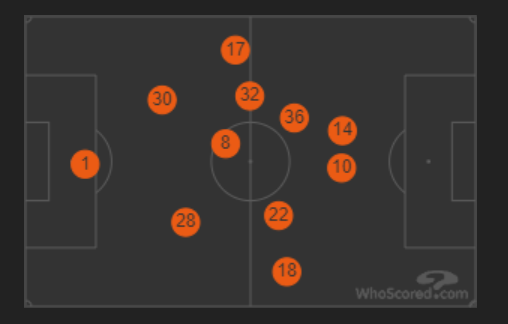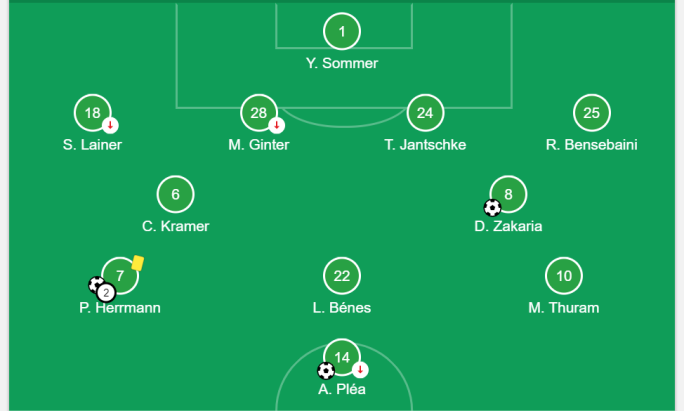Borussia Monchengladbach going from one of the more inconsistent teams in the top of half of the table to title challengers for a large part of the season was quite a story, and Marco Rose has a lot to do with this. The former RB Salzburg coach came into a team who lost their best player in Thorgan Hazard and replaced him with Marcus Thuram and Breel Embolo; two players, while promising, needed some refinement to turn them into players as productive as the Belgian forward. While Embolo is yet to find his feet for his new club, Thuram has turned into a star. Two full-back acquisitions in Ramy Bensebaini on the left and Stefan Lainer (who played under Rose in Salzburg) on the right also gave the team a lot more creativity down the flanks.
One of Rose’s goals was to oversee the development of the team’s younger players. It’s a job familiar to the 43-year-old, who helped his former club develop the likes of Hannes Wolf, Xaver Schlager and Takumi Minamino; who’ve all left RB Salzburg to join clubs in the top five leagues. Gladbach currently has some great young players. The already mentioned Embolo and Thuram, as well as Nico Elvedi, Dennis Zakaria, Laszlo Benes and the player we’ll be discussing today: Florian Neuhaus.
Neuhaus is a player who’s potential has been apparent since his teenage years. Neuhaus, when playing for 1860 Munich’s youth team, scored the winner in the German youth cup final with an 89th-minute winner from the halfway line in a 2–1 win over Borussia Dortmund. After making his first appearance for the senior team in 2016, Gladbach swooped in and signed the promising young midfielder the following year. Neuhaus was loaned out to Dusseldorf, where his standout performances helped the club earn promotion to the Bundesliga. Neuhaus has been one of the brightest midfield talents in Germany and was excellent during the first half of the 2018/19 season. Neuhaus topped the team for assists with seven by Christmas and looked ready to be playing at the highest level, week in week out. However, he was another player who’s form dropped off after the winter break, only going on to assist another goal.
I was intrigued to see what Rose could do with the 23-year-old, and for the first few months of the season, he underwhelmed. It wasn’t to say I thought Neuhaus was playing poorly. The former 1860 Munich midfielder was still creating a lot of chances and showing a lot of maturity and intelligence in possession. But other players quickly took the spotlight away from him. Dennis Zakaria is as good as Neuhaus on the ball while being able to offer superior physicality and defensive actions. Christoph Kramer is the most defensive-minded player out of the team’s midfielders and gives the younger players less defensive responsibility. Laszlo Benes had a real breakout season before suddenly falling down the pecking order, offering great movement and technical ability.
When the Bundesliga returned after Germany’s lockdown was lightened, Neuhaus had a chance to stake a claim on starting every week. Dennis Zakaria suffered a knee injury at the start of March, and Neuhaus was the clear first choice to fill in for him.
The 23-year-old’s performances have been excellent since the return, but before discussing why, let’s first talk about how he plays. Gladbach primarily attacks through their full-backs. Stefan Lainer is one of the team’s most constant creators at full-back, with the defender given full licence to push forward and create for the forwards. Because of creativity shouldered by other players, it provides Neuhaus with two crucial roles. The first is giving the ball to the full-backs. Gladbach looks to transition the ball as quickly as possible, either through long balls to one of the strikers, or waiting for Lainer to make one his usual darting runs forward. Neuhaus does play a part in this. The German midfielder rarely ever holds onto the ball for too long. His vision and awareness enable him to see his passing options before he even receives the ball. He’ll always look to play the ball first time into the path of Bensebaini or Wendt to help drive the ball forward. The urgency in his passing makes him challenging to press. Not only does Neuhaus play these quick balls that cause many issues for opposition midfielders, but he’s also able to dribble through players effortlessly, giving him another effective method of ball progression. Neuhaus has been one of Gladbach’s best dribblers this season, attempting 2.54 dribbles per 90 with a 73.4 success rate; only Zakaria averages the same high amount with a similar success rate.
Neuhaus’s biggest strengths are all on the side of ball progression. But he isn’t afraid to help his team in the opponent’s penalty area. Neuhaus is third in the squad for passes into the penalty area with 28, only behind Steffan Lainer and Alassane Plea. The former 1860 Munich midfielder is an adept passer who is willing to take risks if it aids in giving his team a goal. Yet, it’s the way he helps his team off the ball I find more interesting. If Gladbach needs a goal, Neuhaus will offer support in the box, through late runs to give one of the full-backs another option, or to open up space for one of the attacking players.
One area in which Neuhaus excels in is counter-attacks. When Gladbach is on the break, it brings out one of Neuhaus’s best qualities; his awareness of what’s around him. Neuhaus likes to drive the ball with speed, dragging defenders towards him and opening up space for his teammates. He did this fantastically in Borussia Monchengladbach’s 3–1 victory over Paderborn. After recovering the ball and beginning a counter-attack, Neuhaus receives the ball and quickly dashes towards the opposition box. None of the Paderborn players wanted to make a challenge since it resulted in a Gladbach set-piece. Multiple players surrounded the young German midfielder and instead of shooting, chose to play the ball to Patrick Herrmann, who had acres of room due to Neuhaus’s run. While Herrmann did waste the chance, it perfectly showed just how good of a decision-maker Neuhaus is, able to make the right choice under tough circumstances.
It’s clear Neuhaus excels during the attacking phase, but how does he perform on the defensive end? I wouldn’t say Neuhaus is terrible defensively, but he isn’t excellent either. He’s competent enough not to be a consistent liability, but doesn’t do enough to make his defensive work have any potential positive effect on selection or transfers. Neuhaus does work in the system Rose prefers. The 23-year-old plays on the left of a midfield two or three. He is very disciplined and never strays too far from his midfield partner, and usually attempts to stay on his feet and rarely rush in with a big challenge. Neuhaus puts up a respectable 19.6 pressures per 90, showing that most of his defensive actions have come through attempting to force his opponent to make mistakes. There is one specific issue with Neuhaus defensively, being ball-watching. When defending against teams who dominate the ball, Neuhaus struggles when dealing with dangerous runs from midfielders. Their recent defeat to Bayern Munich highlighted this error, where Neuhaus failed to intercept the switch-ball to the Bayern wide-player, and then allowed Goretzka to score the winning goal.
I like Florian Neuhaus a lot. He offers a unique skill set at such a young age for a midfielder, showing a lot of maturity and excellent decision making on and off the ball. I highly doubt Neuhaus will be going anywhere this summer. It’ll give him a chance to develop his strengths while also improving on the defensive side. Neuhaus has the potential to be a key player for not only his club but his national team in the future.




